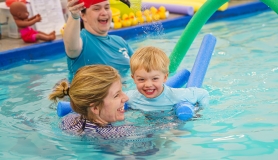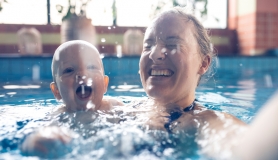Breastfeeding can be a tricky business, as anyone who’s experienced the foggy sleep deprived new born days will know.
At the start, life seems like one long, never-ending cluster feed. During the middle period; things settle down hopefully, confidence is high and all is rosy. Then the final dilemma is when and how to end the feeding.
I’ve loved my breastfeeding journey, the exclusive relationships it has fostered, and the physical and emotional legacy left behind. But I also remember being alone and struggling to feed my firstborn in the small hours of the night. The shock and difficulty of early feeding helped me understand why so many people throw in the towel early on. Recent figures show that Britain has the lowest rate of breastfeeding in the world, with 81 per cent of new mothers trying breastfeeding at some point, 34 per cent still feeding at six months, and 0.5 per cent still feeding beyond the first year.
STARTING POINT
I gave breastfeeding almost no thought during my first pregnancy, I was distracted with buying cute things, and focused on labour. My diary was blank after the due date.
My husband and I went to the NHS antenatal classes which included a brief talk on breastfeeding. At the NCT classes, a longer session on breastfeeding provided a chart of a typical day, showing what your daily routine might look like. Partners were not invited to this talk, which felt strange as having a supportive and informed partner makes a good deal of difference in successful breastfeeding.
My daughter was born in the afternoon and I didn’t really try to feed her until the following morning. I was tired from the birth, and too dazed by everything to realise the importance of feeding her as soon as possible. She seemed content to lay in her cot, and I tried to get some sleep. In the morning she was having trouble latching on, I asked for some help from the midwives and got five minutes of guidance. By late morning we were discharged as the bed was needed again.
At home I tried again and again to get a latch established. I watched my daughter get hungrier and hungrier. I used a manual breast pump to try and get my supply going, I expressed colostrum into a syringe tube and drip fed her. I sat up night after night, turning into a tearful, exhausted shadow of my former self, trying vainly to get her to latch on. It was a desperate, horrible time.
At four days old, her weight had dropped below the acceptable mark and we were readmitted to hospital. Overnight we turned a corner. Then, I spent the next six weeks glued to the sofa, a 24 hour feeding station. When she was a week old I learned how to feed lying down on my side, this was crucial for sleep survival.
“Breastfeeding was free, portable, on tap, it didn't need any preparation and it felt great”
LOVE JUICE
After a couple of months of this intense feeding, my daughter could go for longer between feeds. The cluster feeds eased off and we fed everywhere together; in our local cafe, on park benches, on the train, in the doctor’s waiting room, in bed and at the dinner table. Sometimes I had to drape a tea towel over her head to avoid showering her with spaghetti bolognaise. Breastfeeding was free, portable, on tap, it didn’t need any preparation and it felt great.
I began weaning her onto solid foods around six months, and continued to breastfeed her until she was 14 months old, at which time she was down to one feed a day in the morning time. She suddenly seemed to lose interest, which I took as my cue to stop. By this time I was already pregnant with our second child.
During the next pregnancy, I did a lot of preparation for the post-partem weeks, such as making batch frozen meals, enlisting granny help with my older child, de-cluttering and generally preparing for life with a demanding toddler and a tiny baby. I knew what to expect this time and this made things a lot easier, and also more relaxed.
SECOND TIME
I fed my second daughter within an hour of the birth. She was also a limpet, but a very contented one. I settled back into the groove of feeding her in bed, co-sleeping, and wearing her in the sling during the day. We went to playgroups, because we were following my eldest’s existing routine, which meant that I could sit and feed the limpet and it kept me from becoming isolated.
At around four weeks I got mild mastitis, from wearing a nursing bra that didn’t fit properly. It was like having flu. I was laid out in bed with a fever and a throbbing pain in the side of my breast. After she filled out and we got past the first six weeks, it was plain sailing again, lots of blissful feeds and cuddles, right up to my last feed with her at 15 months old, when her milk teeth were starting to chafe and I was ready to have my body back to myself.
It was worth all the struggles and persevering at the start, but these challenges should not be necessary. Isolation and a lack of support at critical times are the key culprits for women experiencing difficulties with breastfeeding.
CULTURAL APPROACH
During my shell-shock early weeks as a first time mother, when I was having to master the skill of breastfeeding with no prior training, my husband was at work all day, my extended family lived miles away, and bar the occasional fleeting family visit or a meet-up with a friend, I was alone. I remember thinking, when my daughter would not let me put her down for a minute so that I could so much as go to the toilet: “This is ridiculous. No-one has ever expected this of me before. If this was a paid job, it would be illegal!”. It was relentless work with no breaks, and it was isolating.
I later learned that in many collectivist cultures where formula milk is not readily available, the family of the new mother rally round and support her in the months around the birth, waiting on her hand and foot so that she is never alone and never has to think of anything but feeding and bonding with the new baby. In short, everyone supports the breastfeeding to make sure that it works, because it has to.
This seems so intuitive and obvious to me, but this basic community support is often lacking at key moments in people’s lives. Ideally, one would have a live in cook, cleaner, shopper and older child minder for the first six weeks after having a baby. It sounds like heaven.
There is an unrealistic version of modern motherhood fed to us by mainstream culture. Magazines show women with a full face of make-up holding perfect babies, with not a spit-up stain in sight. If a more honest picture of early motherhood was portrayed in the media, complete with the pitfalls of sleep deprivation, postnatal depression, the relentlessness of feeding and the feelings of isolation, this would have a profound effect.
I would been relieved knowing that it’s normal to cry and to be overwhelmed with emotion, that I don’t have to look immaculate or keep the house clean during those early months.
MAKE YOUR OWN STARTER KIT
Recently I was searching for a birthday present for my sister-in-law, who is expecting a baby, and hit upon a ‘breastfeeding starter kit’ idea, as a way to support her through her post-partum days. Here are my ideas for making those first few weeks easier for people who are breastfeeding for the first time:
- Nipple cream (for the first two weeks of chafing from being gummed 24/7)
- Nipple shields (for when the chafing gets really bad and you need a bit more protection)
- Nursing bras (I like night time bras which don’t have any seams or clippy bits. They are more like crop-tops with stretchy cross-over panels that you can pull to the side for quick hassle free feeding, essential for when you’re half asleep)
- A U shaped pillow (to rest your arms on)
- A neck pillow (just to make you really comfy)
- A trolley table that you can stock up with drinks and snacks, notebook etc.
- Muslin cloths (for spit up and general spillage)
- Baby sling (for wearing them around the house, or out and about)
- Breastfeeding multi-vitamins (as an insurance policy to make sure you don’t get run down, and because cooking proper food will probably go by the wayside for a while).
- Breast pump, for occasional deflating when needed (saves your breasts from exploding).
- Breast pads, for those who suffer leakage. I never did, but it’s handy to have them just in case.
MORE INSPIRATION
Sarah blogs at moleandhedgehog.com







